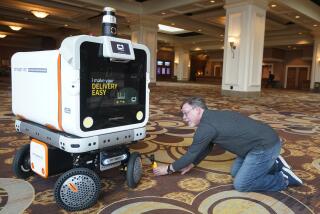Electronics Show--a Mix of Old, New
- Share via
LAS VEGAS — While exotic new gizmos such as pocket-sized “digital assistants,” interactive multimedia players and next-generation digital audio devices hog the limelight at the Consumer Electronics Show here, it is the comparatively mundane products--big-screen TV sets, video-game machines and car stereos--that are driving an unexpected sales boom in the industry.
Total sales of consumer electronics products increased 7.9% to $38.2 billion for 1992, according to the Electronics Industries Assn., a big improvement over the 2% to 3% growth rates of recent years. Much of the sales spurt came in the last few months of the year as recession-weary consumers began to shop again.
“Our dealers say business has really picked up in the last 90 days after being very slow over the summer,” said Shoichi Yamada, chief executive of Pioneer Electronics’ U.S. operations.
Traditional products such as color TV sets (up 9%), stereos (up 7%) and video-game systems (up more then 25%) have led the charge. While new products such as big-screen TVs and compact disc-based video-game machines also contributed to the upturn, falling prices and rising consumer confidence appeared to be the key factors.
In the game business, a competitive battle between Nintendo and Sega led to big price cuts on key pieces of game hardware--and a huge increase in sales. Nintendo said 1992 revenue for all Nintendo machines and game programs leaped by 22% to nearly $4.3 billion after showing virtually no increase in 1991.
Sega, for its part, said revenue more than doubled to $1.6 billion from $730 million in 1991. Both companies are fueling the fire this year with a host of new games and accessories. Nintendo has introduced a special chip that can be incorporated into its game cartridges for superior graphics performance, while Sega rolled out an attachment that allows the player to control the game by intercepting beams of light with their hands.
A key test for the coming year will be whether Sega can sustain the momentum of its new $300 compact disc game system, which sold out during the Christmas season. Nintendo also plans a CD system but has chosen to delay it until next year--in part because of a belief that few game enthusiasts are willing to pay much more than $100 for a machine unless it boasts phenomenally improved game-playing.
Meanwhile, a slew of new consumer products that take advantage of advances in computer technology will not begin to affect the bottom line of vendors and retailers until later this year.
Apple Computer, which first outlined plans for a pocket-sized communicating computer, or “personal digital assistants,” at CES a year ago, on Friday said the Newton devices, as they are now named, will not begin appearing on store shelves until this summer at the earliest.
Tandy and Casio are working together on a similar product, dubbed the Zoomer, which they plan to introduce in the fall. Though they are different in many respects, both the Newton and the Zoomer are lightweight devices which are operated with a pen and function as personal organizers, mobile fax machines and miniature information terminals all rolled into one.
3DO Co., a start-up company backed by Japan’s Matsushita, Time-Warner and AT&T;, also plans a fall roll-out for its interactive entertainment machine, a kind of souped-up game system with vastly improved graphics, animation and video capabilities.
By contrast, the two new digital audio formats--Digital Compact Cassette and Mini Disc--have been on the market for several months. But Sony’s Mini Disc, which can play and record music on a palm-sized version of the compact disc, has been in such short supply that consumer acceptance is difficult to gauge.
Dealers say that the DCC, spearheaded by Philips and Matsushita, has been selling slowly but that it’s still much too early to tell whether it will succeed.





